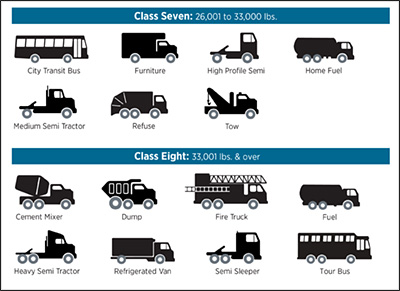In the transportation industry, trucks serve as the backbone for the efficient movement of goods across vast distances. However, not all trucks are created equal, and when it comes to hauling heavier loads, specific vehicles are required. This article aims to shed light on the trucks that weigh 26,000 pounds, exploring their capabilities, uses, and the regulations that govern their operation. Whether you are a logistics professional seeking to expand your knowledge or simply curious about the different types of trucks on the road, understanding the intricacies of these vehicles is essential.
What Trucks Weigh 26,000 Pounds?
Understanding Truck Weight Classes
Truck weight classes are categorizations that help determine the weight range and capabilities of different types of trucks. These weight classes not only determine the size and weight capacity of the truck but also impact other factors such as licensing requirements and operating regulations. When it comes to trucks weighing 26,000 pounds, they fall primarily within the Class 6, Class 7, and Class 8 weight categories.
Class 6 Trucks
Class 6 trucks have a Gross Vehicle Weight Rating (GVWR) ranging from 19,501 to 26,000 pounds. These trucks are commonly used for medium-duty applications such as local delivery trucks, utility service trucks, and construction vehicles. With their versatile weight capacity, Class 6 trucks are suitable for a wide range of industries and are often equipped with various body configurations to accommodate specific transportation needs.

This image is property of weightofstuff.com.
Class 7 Trucks
Moving up the weight scale, Class 7 trucks have a GVWR between 26,001 and 33,000 pounds. These trucks are often employed in situations that require heavy-duty hauling capabilities, such as regional distribution, waste management, or towing services. Class 7 trucks are designed to handle demanding tasks while providing a balance between weight capacity and maneuverability.
Class 8 Trucks
Class 8 trucks represent the highest weight class among commercial vehicles, with a GVWR exceeding 33,000 pounds. While they might not fall directly within the 26,000-pound range, it’s worth mentioning them as they provide valuable insights into heavier truck categories. Primarily used for long-haul transportation, Class 8 trucks are the backbone of the freight industry, carrying goods over long distances efficiently and effectively.

This image is property of weightofstuff.com.
Medium Duty Trucks
Apart from the official weight classes, there is an additional category known as medium-duty trucks, which often includes trucks with a GVWR ranging from 14,001 to 26,000 pounds. These trucks are smaller in size compared to their heavier counterparts but still offer significant payload capacity. Medium duty trucks are typically seen in applications such as local delivery, short-haul transportation, and light-duty construction projects.
Popular Truck Models
Various truck models fall within the weight class of 26,000 pounds. Here are some popular models from different manufacturers that align with this weight range:
- Ford F-650
- Freightliner M2
- International Durastar
- Hino 338
- Isuzu NQR
These models represent a range of truck configurations, body styles, and engine options, allowing businesses to choose the right combination for their specific needs.

This image is property of weightofstuff.com.
Truck Manufacturers
Several esteemed manufacturers produce trucks with a weight range of 26,000 pounds. Companies such as Ford, Freightliner, International, Hino, and Isuzu are well-known for their reliable and durable trucks in various weight classes. Each manufacturer offers different features, customization options, and after-sales support, ensuring that customers can find the ideal truck for their operations.
Truck Features
Trucks weighing 26,000 pounds come equipped with numerous features designed to meet different industry requirements. Some common features include:
- Powertrain options: Manufacturers offer a range of engine choices, including gas, diesel, or even alternative fuel options such as electric or hybrid. This allows businesses to match their trucks’ power and fuel efficiency to their specific needs.
- Driver comfort: Many trucks now provide advanced driver comfort features, including air-conditioned cabins, ergonomic seats, and enhanced visibility. These features help improve driver productivity and overall job satisfaction.
- Safety systems: With the increasing emphasis on safety, trucks now come equipped with various safety features such as collision warning systems, lane departure warnings, and advanced braking systems. These safety measures not only protect the driver but also help reduce accidents on the road.
- Connectivity: Many truck models now offer advanced telematics systems, allowing businesses to monitor the performance, location, and maintenance requirements of their fleet. This connectivity assists in optimizing operations and reducing downtime.

This image is property of nhcleancities.org.
Payload Capacity
When considering trucks weighing 26,000 pounds, payload capacity becomes a crucial factor. It refers to the maximum weight of the cargo a truck can carry while still staying within legal limits. The payload capacity of a truck depends on various factors, including the truck’s weight class, chassis strength, and configuration. It is important to ensure that the payload doesn’t exceed the Gross Vehicle Weight Rating (GVWR) to maintain safety and compliance with regulations.
Licensing Requirements
Operating a truck weighing 26,000 pounds often comes with specific licensing requirements. These requirements ensure that drivers possess the necessary skills and knowledge to operate the vehicle safely. In the United States, individuals need a Commercial Driver’s License (CDL) with appropriate endorsements depending on the truck’s weight class, cargo type, and any other regulatory requirements. It is crucial to comply with these licensing requirements to avoid fines and penalties while safeguarding the safety of the driver, the cargo, and other road users.
Understanding the different truck weight classes, popular models, manufacturers, features, and licensing requirements related to trucks weighing 26,000 pounds is essential for businesses and drivers involved in the transportation industry. By selecting the right truck and adhering to the necessary regulations, businesses can ensure efficient operations, meet customer demands, and maintain safety standards.

This image is property of weightofstuff.com.
